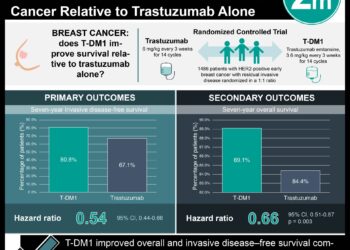Clinicopathological heterogeneity in triple-negative breast cancers associated with variable prognosis and therapeutic outcomes
1. Heterogeneity in histological profile linked to improved overall survival, chemotherapy response, and clinical course despite triple-negative receptor status in three rare breast cancer histological subtypes.
2. Metaplastic breast carcinoma had the worst 5-year overall survival (OS) among the subtypes studied and factors associated with its poor prognosis included advanced stage, lung metastasis, older age, and not receiving chemotherapy or radiation therapy.
Evidence Rating Level: 2 (Good)
Study Rundown: Rare breast cancers with triple-negative receptor immunohistochemistry are defined by lacking the expression of estrogen receptor (ER), progesterone receptor (PR), and ERBB2 (formerly HER2). Although chemotherapy is currently the mainstay systemic therapy, patients with triple-negative breast cancer have poor outcomes due to the inherent aggressive clinical course of the tumor and the lack of targeted therapies available. Triple-negative breast cancers are medically managed as a single group and as a result, this leads to chemotherapy resistance among various subtypes. This retrospective, open cohort study sought to investigate the degree of heterogeneity among triple-negative breast cancers in the United States over a 7-year period by comparing their clinical, pathological, and molecular features from the National Cancer Database (NCDB). The main objective of the study was to outline the clinical presentation and management of triple-negative breast cancers, analyze OS, and investigate the association of the triple-negative histological subtype with metastasis for medullary carcinoma, adenoid cystic carcinoma, and metaplastic breast carcinoma. Using the eligibility criteria based on histological diagnosis, year of diagnosis, and staging, a total of 8479 patients with breast cancer were included in the analysis. Metaplastic carcinoma was the most commonly diagnosed histological type in this cohort, with 6867 patients (81%), followed by 1357 (16%) with adenoid cystic carcinoma and 255 (3%) with medullary carcinoma. The 5-year OS rate was superior for patients with medullary (91.7%) and adenoid cystic carcinoma (88.4%) compared with patients with metaplastic carcinoma (63.1%). These preliminary findings suggest that clinicopathological heterogeneity within triple-negative breast cancer subtypes may be associated with overall survival, treatment response, and clinical course. Further research focusing on these rare subtypes is required in order to improve prognosis and develop more clinically efficacious targeted therapies for triple negative breast cancer. A limitation of this study was the lack of information on the genomic profiles of the breast tumors and levels of claudin and Ki-67 protein. These cellular markers play an important role in cell proliferation and turnover, thus, providing prognostic and therapeutic value to the study.
Click to read the study in JAMA
Relevant Reading: Comparison of outcomes between metaplastic and triple-negative breast cancer patients
In-Depth [retrospective cohort]: This retrospective, open cohort study was performed in the United States between 2010 and 2016 using data reported by the NCDB, a registry containing approximately 70% of all cancer cases diagnosed in the country. NCDB cases diagnosed with a histologically rare breast cancer of triple-negative immunohistochemistry status were eligible and cases of medullary carcinoma, adenoid cystic carcinoma, or metaplastic carcinoma, as determined by the International Classification of Disease for Oncology (ICD-O3) were included for final analysis. After screening, a total of 8479 patients with rare breast cancer (mean [SD] age; 62.6 [14.3] years; 8435 women [99.48%]) were included. Of these, metaplastic carcinoma was the most common histological subtype with 6867 patients (81%), followed by adenoid cystic carcinoma with 1357 (16%) and medullary carcinoma with 255 (3%). At the time of diagnosis, medullary carcinoma had the lowest median age (53 [IQR 45-62] years) compared to adenoid cystic carcinoma (62 [IQR 53-72] years) and metaplastic carcinoma (63 [IQR 52-74] years). Secondary outcomes of the study included site of metastasis and management. Only metaplastic carcinomas were associated with metastasis. Triple-negative metaplastic breast carcinoma was more likely than the other histological subtypes to metastasize to the lungs (OR, 2.04, 95%CI, 1.48-3.88; P < 0.001) and the bone (OR, 1.75; 95%CI, 1.20-2.55; P = 0.003). In terms of management, patients with adenoid cystic carcinoma were less likely to receive radiotherapy (711 patients [52.4%]) and chemotherapy (175 patients [12.9%]) compared to patients with medullary carcinoma (radiotherapy, 156 patients [61.2%]; chemotherapy, 190 patients [74.5%]) and metaplastic carcinoma (radiotherapy, 3416 patients [49.7%]; chemotherapy, 4709 patients [68.6%]). For the study’s primary outcome, 5-year OS was superior in patients with medullary (91.7%) and adenoid cystic carcinoma (88.4%) compared to metaplastic carcinoma (63.1%). In contrast, the 5-year mortality rate was 8.33%for medullary carcinomas, 11.61% for adenoid cystic carcinomas, and 36.91% for metaplastic carcinomas. Kaplan-Meier survival analysis revealed that OS was best for patients with medullary carcinoma at all stages.
Image: PD
©2021 2 Minute Medicine, Inc. All rights reserved. No works may be reproduced without expressed written consent from 2 Minute Medicine, Inc. Inquire about licensing here. No article should be construed as medical advice and is not intended as such by the authors or by 2 Minute Medicine, Inc.







